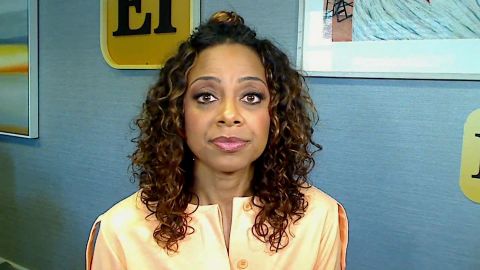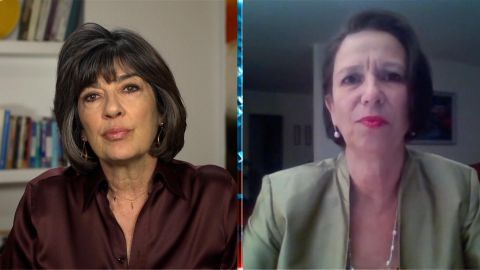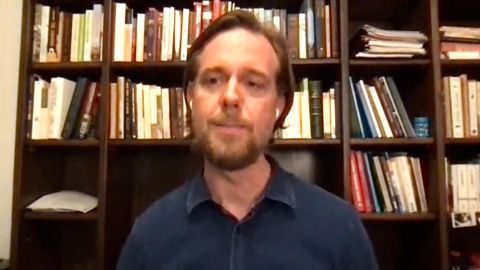Read Transcript EXPAND
CHRISTIANE AMANPOUR: Global warming and climate change call evermore loudly for us humans to green up. But could our attempts at saving the environment also be part of the problem. Elizabeth Kolbert is a Pulitzer prize winning environmentalist. She’s a journalist and staff writer for “The New Yorker.” Her new book, “Under a White Sky,” looks at some of the unique efforts to solve the climate crisis. And she’s joining our Hari Sreenivasan to discuss these climate interventions and their unintended consequences.
HARI SREENIVASAN: Christiane, thanks. Elizabeth Kolbert, thanks for joining us. You say in book that this is a book about people trying to solve problems created by people trying to solve problems, and explain that.
ELIZABETH KOLBERT, AUTHOR, “UNDER A WHITE SKY: THE NATURE OF THE FUTURE”: Well, a lot of the stories that I tell in the book began with tremendous — for example, engineering projects. The first story in the book deals with the Chicago River, which is actually reversed in the early part of the 20th century, the flow of the river. And that was done to solve Chicago’s sewage problems. But the way that was accomplished, this huge engineering project that was, you know, really the biggest — one of the biggest engineering projects of its day was to connect it up with the whole Mississippi water system and Mississippi drainage basin. And that had the effect of connecting these two previously separate drainage basins, it’s the Great Lake drainage basin and then Mississippi drainage basin. And that has allowed species to cross who should not be allowed to encounter each other to cross from one basin to another. And that has become an issue in the 20th century as both of these water basins have become highly invaded water basins. And you have a lot of invasive species wreaking havoc separately and the two water basins that people don’t want to be able cross from one to another.
SREENIVASAN: Well, one of the species that we’re concerned about, at least, along the Chicago River is the different species of Asian carp. And what are the types of efforts that we have made or are making now to try to prevent just this fish?
KOLBERT: The biggest one right now is that you get to a section of this canal that was built to reverse the Chicago River and it’s electrified and you will see these huge signs that say, you know, keep your kids and pets nearby if you are, you know, on a boat, because if they jump in the water, they will be electrocuted, high danger of, you know, electric shock. And so, that electrification, these electric barriers they are called, that is designed to — if you are a fish, you’re supposed to sort of nudge up against this barrier, feel a shock and turn around and go home, that’s basic the hope. But no one really wants to completely rely on this technology. So, there is also a lot of what is called the barrier defense, which consist of just basically fishing for Asian carp, tossing them, you know, into a big vat, which I watched this process as well, and grinding them up and using them for fertilizer. So, you know, there’s a lot of efforts, a tremendous effort to try to keep the Asian carp out of the Great Lakes.
SREENIVASAN: You go from manmade caves where scientists are trying to save a specific species of fish to laboratories where there’s literally cross breeding of coral or attempts at it, and then you talk a little bit about what we trying to do to stop a poisonous frog. And tell us about the cane toad and what humans are trying to do.
KOLBERT: So, the cane toad is a toad that’s native to the south and Central America that was exported around the world in the vain hope that it would control beetles that were eating sugar cane crops in various places, the Caribbean. And in Australia, they’ve really wreaked havoc in there. You can tell the story in a kind of a comic way that Australians have tried every which way to try to kill cane toads, they run them over with their lawnmowers, they bash them with golf clubs, they freeze them in the freezer, and nothing has put a dent in them. They are continuing to expand their territory. And they are dangerous to Australia’s native wildlife because they are highly toxic. And if you’re not having evolved in their presence, you chomp into you and you die if you’re a marsupial or a reptile or a person, just for that matter. And so, I went to visit some scientists of this incredibly (INAUDIBLE) secure facility outside of Melbourne where they were gene editing cane toads with the help of this, you know, cutting edge crisper to try to make them nontoxic, essentially nontoxic cane toads. And they had actually succeeded in doing that. I met some very interesting, you know, nontoxic cane toads.
SREENIVASAN: I mean, implied and unattended consequences is that we really — we didn’t plan for them, but can we plan for it? Because whether it’s the cane toad or it’s, you know, the escape of Asian carp into our streams, each time we try to solve one of these problems we come up with three or four other problems, and how do we mathematically solve for that? How do we prepare for that any eventuality especially with something sensitive as generic (ph)?
KOLBERT: Well, I think that’s a huge question and, you know, many people who are working on these issues are trying to grapple with those questions right now. I don’t we have an answer for that. We are — you know, biological and geochemical systems are very complicated and find — we should approach them with a lot of humility, frankly. But that doesn’t mean that there aren’t amazing things that can be done. We’ve also done amazing things as human beings, that’s, you know, why we’re in the (INAUDIBLE). So, these technologies, a lot of them, they are double- edge swords and saying, well, we should only take the good parts and not the bad parts is what, you know, optimally we should do, but the track record, as you would suggest, is not that great.
SREENIVASAN: You know, there’s the idea that we have the power today to start playing God. Are we good at it yet? I mean, do we have a choice not to in some of the cases like say the king?
KOLBERT: Well, I think one of the profound issues that we are grappling with is that, you know, in the Anthropocene, we already are playing God, we are not just doing it consciously, right. So, we are changing the climate, we are changing the biosphere. When we are move species around the world, you know, purposely or inadvertently, as we are doing every single day, I mean, there is an estimate that 10,000 species are being moved around the world every day in the ballast water of our super tankers. So, every day we’re changing the world, you know, inadvertently and sometimes we’re changing it very consciously, you know, through farming, through — agricultures had massive effects, you know, putting up dams, you know, the list goes on and on. And I think that the lesson is we sort of are already are playing God, we’re just not thinking about it. And the question is, if we do think about it more carefully, will we get any better at it? And that’s a pretty big question, and that is certainly the question at the heart of the book, are we capable of that? And I don’t have the answer to that question.
SREENIVASAN: One of the areas that I think people would almost want a God- like solution is climate change. It’s happening. It’s real. The science shows it. We have had a tremendous impact on accelerating it. You speak to a range of different scientists and researchers and even private companies that are working to solve this. One of them is — one of the ideas is to shove CO2, take it out of the air, shove it back into the ground, turn it into rock again. How does that work?
KOLBERT: Yes. It’s an amazing, you know, technology. I mean, taking CO2 out of the air. CO2 is basically an acid and you can take it out of the air using chemicals that are basic, that will bind with it. Then you heat up those chemicals and push the CO2 off and you can bury it underground. I visited, you know, my own emissions theoretically in Iceland which had been sucked out of the air to this machine that look like an old air conditioner and then it was being piped almost a mile underground into this volcanic rock where it would react with the rock and form calcium carbonate and basically be solidified. And that is a viable technology. It’s just extremely expensive. And the question is, you know, can we scale up that technology or any technology to really make a measurable dent in our own CO2 emissions? That is something that is urgently required, to be honest. Something — some form of that which could — because it is already built into all of these calculations of how we are going to keep the temperatures under from rising more than 2 degrees Celsius. There’s already a lot of carbon dioxide removal, it’s called, built into those calculations. So, a lot of people, you’re going to be hearing more and more about that in coming years because it is really necessary.
SREENIVASAN: You also talk to people who are thinking about the ideas of spraying, well, almost diamond bits or the bits of the limestone into the air to try to — well, what are they trying to do with it? Why would you want to do something like that?
KOLBERT: Even at the point that we stopped emitting CO2, which, as I say, I hope we could do as soon as possible, we still have a radically changed climate and we know that, you know, there are a lot of ecosystems and there’s lot of the parts of the world, you know, where agriculture could be threatened. And if we wanted to, you know — really, you hear people talk about reversing climate change, and the only idea that people have come up with so far that seems even theoretically possible to do that is to counteract all the CO2 or part of the CO2 that we’ve, you know, already pumped into the atmosphere and continue to pump into the atmosphere by putting some kind of particulate matter into the stratosphere where it would sort of float around, create the sort of stratospheric haze, this is what happens after a big volcanic eruption, we get a lot of sulfur dioxide and the stratosphere this haze, creates beautiful sunsets, and it has a temporary cooling effect because it is reflecting sunlight back to space before it hits to the earth — hits earth. So, you’re getting less direct sunlight on earth. So, the idea is perhaps you could use this to create cooling that would counter act some or all of the warming. Now, you know, obviously that raises tremendous questions.
SREENIVASAN: It’s just mindboggling to think about spraying anything around the entire planet. But the amount of energy you would have to use to, let’s say, get planes into the sky to disperse this and then not to mention that we’d still be pumping CO2 into the atmosphere. So, you’d have to keep pumping more and more or spraying more and more to try to cover this up, wouldn’t we?
KOLBERT: Well, I guess the best-case scenario, and I am offering this once again in theoretical terms, would be ramping down CO2 emissions, you wouldn’t be ramping them up. If you continue to ramp them up, I think pretty everyone would agree, you’re getting into some very, very dangerous territory. Now, even if you are ramping them down, you may be getting into some very, very dangerous territory. But I think that one of the messages, I think, of the book is for better or worse, you know, we are not in a situation where we have great answers where this the panacea that’s just going to make all of these problems go away. The world is altered. We’re continuing to alter it. We’re not getting back the planet, you know, that we had. And we’re going to have to make some very difficult decisions, and hopefully, we make them wisely. But once again, as the world becomes more imperiled, it is not clear how the political system will respond to any of these challenges.
SREENIVASAN: What has the pandemic done to this? Has it kind of brought into focus this affect that we have?
KOLBERT: I mean, I think that the pandemic really, that COVID really follows very much the pattern that I am looking at in the book. It was, you know, a sort of human and natural systems that came together. It is a virus that jumped species. We don’t know how it jumped species, but it clearly came from some other species. That was a product of the way that we interact with the natural world, either someone brought something out of, you know, the woods or the jungle or a domesticated species. And we know that this was a recipe for a pandemic. Many people have talked about the way we deal with animals where it was a recipe for some kind of a big — some kind of outbreak. Then we spread it around the world instantaneously. You know, we — the way we live in this globalized world, you know, the virus was in the Falkland Islands very quickly, one of the most isolated places on earth. And then, even so, we could have still, you know, all stayed home and really tried to bring the virus under control. We didn’t. We really have let it rage out of control. And we are sitting here hoping for a techno fix. Hoping for a vaccine. And, you know, we were very, very fortunate and there’s some really cutting-edge technologies that went into making the vaccines that some of us Americans are getting now, but we are also now worried about, you know, variants that are going to escape these vaccines. And we don’t know where this story is going to end, but it has a lot of the elements that we are talking about, about the ways that humans interact with nature and then things either happen that we don’t care for and we hope that some technology is going to save us, but there’s usually another chapter to it.
SREENIVASAN: Is this part of human nature that we try to problems? I mean, obviously, we have done this since we walked out of the cave, so to speak. But we create other problems in the wake of it and then we have to try to solve those problems. I mean, it just seems like we invent so many things to solve one thing without necessarily thinking about the consequences of how those tools or technologies could be misused by mistake or intentionally.
KOLBERT: Well, there’s sort of a mismatch. I mean, the interesting thing about our species is we are a technological species. There really is no other technological species. And we don’t wait to evolve, you know, a new claw or a new tooth, we just go out and invent something. And when you do that and, you know, lots of things can happen that you didn’t necessarily anticipate. Now, have we been doing that, you know, as you said, since we basically became human, quite possibly, but the stakes were a lot lower, right? Because there were — you know, our technologies just weren’t very sophisticated. And now, as our technologies are incredibly sophisticated, we are still the same people that we were, you know, when we lived in caves. And that has — Ed Wilson — E.O. Wilson has a quote, which I won’t get exactly right, but we basically have, you know, paleolithic brains and space aged technologies, and that’s a complicated situation to be in. And that gets us back to this question of, you know, can we learn how to control ourselves and control our own technologies in time to actually, you know, solve some of these problems or are we just going to sort of, you know, stumble along?
SREENIVASAN: The book is called “Under a White Sky.” Elizabeth Kolbert, thanks so much.
KOLBERT: Oh, thanks for having me.
About This Episode EXPAND
The U.N.’s Special Envoy on Myanmar discusses the country’s unrest and struggle for democracy. Mohammad bin Salman biographer Ben Hubbard discusses relations between the U.S. and Saudi Arabia. Nischelle Turner reacts to the lack of diversity of among nominees during last night’s Golden Globes ceremony. Journalist Elizabeth Kolbert discusses her new book “Under a White Sky.”
LEARN MORE



